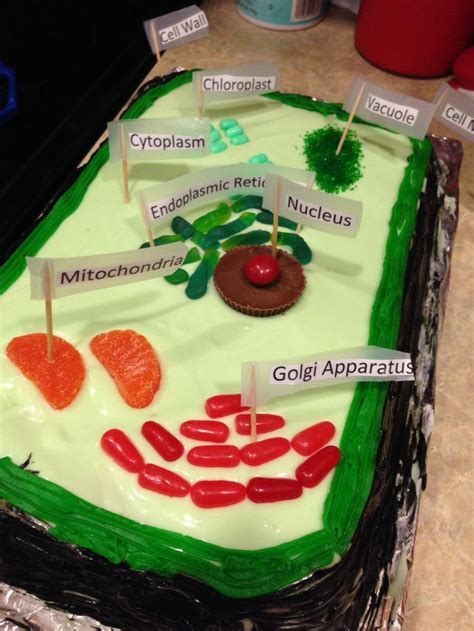Introduction

Biology can be a fascinating subject, but it can also be challenging to understand. One way to make learning about biology more enjoyable and engaging is to use hands-on activities. The cake plant cell project is a great example of a hands-on activity that can help students learn about the structure and function of plant cells.
Materials
To make a cake plant cell, you will need the following materials:
- 1 box of cake mix
- 1 cup of water
- 1/2 cup of vegetable oil
- 2 eggs
- 1/2 cup of frosting
- Green food coloring
- Toothpicks
- Candy (for decoration)
Instructions
- Preheat the oven to 350 degrees Fahrenheit (175 degrees Celsius). Grease and flour a 9×13 inch baking pan.
- In a large bowl, combine the cake mix, water, vegetable oil, and eggs. Beat until well combined.
- Pour the batter into the prepared baking pan and bake for 25-30 minutes, or until a toothpick inserted into the center comes out clean.
- Let the cake cool completely.
- Frost the cake with the frosting.
- Use the toothpicks to create the cell wall, cell membrane, and nucleus.
- Use the candy to decorate the cake to represent the other organelles of the plant cell, such as the chloroplasts, mitochondria, and Golgi apparatus.
Learning Objectives
The cake plant cell project can help students learn about the following concepts:
- The structure and function of plant cells
- The different organelles of plant cells
- The importance of plant cells in the ecosystem
Assessment
After students have completed the cake plant cell project, they can be assessed on their knowledge of the following concepts:
- The structure and function of plant cells
- The different organelles of plant cells
- The importance of plant cells in the ecosystem
Students can be assessed through a variety of methods, such as:
- A written test
- A oral presentation
- A project report
Conclusion
The cake plant cell project is a fun and edible way to learn about biology. This project is a great way to engage students in the learning process and help them to understand the structure and function of plant cells.
- The Plant Cell Wall
- The Plant Cell Membrane
- The Plant Cell Nucleus
- The Plant Cell Chloroplasts
- The Plant Cell Mitochondria
- The Plant Cell Golgi Apparatus
When making a cake plant cell, it is important to avoid the following common mistakes:
- Using too much frosting. Too much frosting can make the cake too sweet and difficult to eat.
- Not using enough toothpicks. Toothpicks are essential for creating the structure of the plant cell. If you do not use enough toothpicks, the cake will not hold its shape.
- Not using candy to decorate the cake. Candy can help to make the cake more visually appealing and fun to eat.
Here are some strategies for success when making a cake plant cell:
- Use a box of cake mix that you like. This will help to ensure that the cake tastes good.
- Follow the instructions carefully. This will help to ensure that the cake turns out well.
- Be patient. Making a cake plant cell can take some time, but it is worth it in the end.
There are many different ways to make a cake plant cell. Here are a few variations:
- Use different colors of frosting to represent the different organelles of the plant cell.
- Use different types of candy to decorate the cake.
- Add other elements to the cake, such as sprinkles or edible glitter.
The cake plant cell project can be used in a variety of educational settings. Here are a few examples:
- Elementary school science classrooms: The cake plant cell project is a great way to introduce students to the structure and function of plant cells.
- Middle school science classrooms: The cake plant cell project can be used to help students learn about the different organelles of plant cells.
- High school science classrooms: The cake plant cell project can be used to help students learn about the importance of plant cells in the ecosystem.
The cake plant cell project is a fun and edible way to learn about biology. This project is a great way to engage students in the learning process and help them to understand the structure and function of plant cells.
